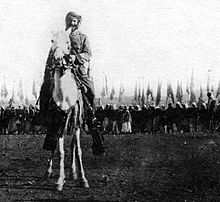Great Syrian Revolt


The Syrian Revolution (1925-1927) is by far the largest, most widespread, and most organized Syrian revolt against the French Mandate. It started in Jabal el Druze then spread to Damascus, Qalamoun, Hama, Golan Heights and south-eastern Lebanon. It was led by the prominent Druze leader Sultan Pasha al-Atrash.
Background
After the end of World War I and the defeat of the Ottoman Empire, Syria was put under the French Mandate. The Syrian government refused the mandate and declared independence. As French forces started to enter the country, they faced revolts in the mountains of Latakia (1919) and in the mountains of Harem in the northwest (1920). These revolts used ambushes and hit-and-run tactics, and were eventually quelled in 1921 after aid stopped coming from Turkey and the Syrian government.

French forces entered Damascus on July 25, 1920 after the Battle of Maysalun. King Faisal fled to Jordan and General Henri Gouraud became High Commissioner. Upon arrival, the French partitioned Syria into five states: Damascus, Aleppo, Alawite State (Latakia), Greater Lebanon, and Jabal el Druze.
Causes
Among the myriad of causes cited by historians for the Syrian Revolt lies the confrontation between the Druze political elite - led by the Atrash clan - and the colonial authorities based in Damascus. The major point of contention between both camps is said to have been the degree of autonomy the French were willing to give the rulers of the Jabal.
For example, under the guise "modernization," the French colonial authorities sought to overthrow the traditional/"feudal" political elite, and impose their own subordinates as governors of the province. This campaign also sought to impose other aspects of "civilization" upon the Druze community, such as a secular judicial system - all of which were meant to undercut established norms and practices in the interest of expanding the influence of the colonial authorities.
The straw that broke the camel's back is said to have been Damascus' appointment of Capt. Gabriel Carbillet as governor of Jabal el Druze. According to Michael Provence, author of The Great Syrian Revolt and the Rise of Arab Nationalism, Carbillet "zealously sought to break the grip of Druze 'feudalism' in the region." In implementing his agenda, Carbillet "conscripted the sheikhs for forced labor on modernizing projects such as road-building." Consequent protests by members of the community "were met with repression, villages raised militia, and the regional capital Suwayda was besieged."
Revolution

On August 23, 1925 Sultan Pasha al-Atrash officially declared revolution against France, and soon Damascus, Homs and Hama attended the revolution, Al-Atrash won many battles against the French at the beginning of revolution. Such battles as Al-Kafir Battle in the July 21, 1925, Al-Mazra'a Battle in August 2, 1925, and the battle of Salkhad, Almsifarh, Suwayda and others. After rebel victories against the French, France sent thousands of troops to Syria and Lebanon from Morocco and Senegal, equipped with modern weapons, compared to the few supplies of the rebels. This dramatically altered the results and allowed the French to regain many cities after fierce resistance lasted until the spring of 1927, The French sentenced Sultan al-Atrash toexecution, but he had escaped with the rebels to Transjordan and he was eventually pardoned. He later returned to Syria in 1937 after the signing of the Syrian French Treaty. He was met with a huge public reception.
The results
- Replacement of High commissioners and military officers in Syria
For example High Commissioner Maurice Sarrail was replaced with Henry de Jouvenel[1], after rebels had attacked al-Azm Palace in Damascus
- Damascus was bombarded severely, and a quarter of the city burned.
- France sent one of the most prominent leaders General Maurice Gamelin after growing strength of the rebels and the victories.
- Reunification of Syria after divided into four small countries: Damascus, Aleppo, and Alawite State, Jabal Druze
- French agreed to the holding of elections won by the opposition, led by Ibrahim Hanano, Hashim al-Atassi
